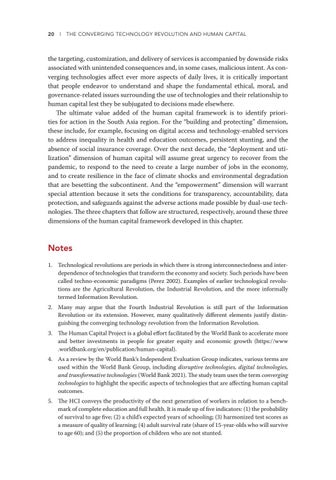20 l THE CONVERGING TECHNOLOGY REVOLUTION AND HUMAN CAPITAL
the targeting, customization, and delivery of services is accompanied by downside risks associated with unintended consequences and, in some cases, malicious intent. As converging technologies affect ever more aspects of daily lives, it is critically important that people endeavor to understand and shape the fundamental ethical, moral, and governance-related issues surrounding the use of technologies and their relationship to human capital lest they be subjugated to decisions made elsewhere. The ultimate value added of the human capital framework is to identify priorities for action in the South Asia region. For the “building and protecting” dimension, these include, for example, focusing on digital access and technology-enabled services to address inequality in health and education outcomes, persistent stunting, and the absence of social insurance coverage. Over the next decade, the “deployment and utilization” dimension of human capital will assume great urgency to recover from the pandemic, to respond to the need to create a large number of jobs in the economy, and to create resilience in the face of climate shocks and environmental degradation that are besetting the subcontinent. And the “empowerment” dimension will warrant special attention because it sets the conditions for transparency, accountability, data protection, and safeguards against the adverse actions made possible by dual-use technologies. The three chapters that follow are structured, respectively, around these three dimensions of the human capital framework developed in this chapter.
Notes 1. Technological revolutions are periods in which there is strong interconnectedness and interdependence of technologies that transform the economy and society. Such periods have been called techno-economic paradigms (Perez 2002). Examples of earlier technological revolutions are the Agricultural Revolution, the Industrial Revolution, and the more informally termed Information Revolution. 2. Many may argue that the Fourth Industrial Revolution is still part of the Information Revolution or its extension. However, many qualitatively different elements justify distinguishing the converging technology revolution from the Information Revolution. 3. The Human Capital Project is a global effort facilitated by the World Bank to accelerate more and better investments in people for greater equity and economic growth (https://www .worldbank.org/en/publication/human-capital). 4. As a review by the World Bank’s Independent Evaluation Group indicates, various terms are used within the World Bank Group, including disruptive technologies, digital technologies, and transformative technologies (World Bank 2021). The study team uses the term converging technologies to highlight the specific aspects of technologies that are affecting human capital outcomes. 5. The HCI conveys the productivity of the next generation of workers in relation to a benchmark of complete education and full health. It is made up of five indicators: (1) the probability of survival to age five; (2) a child’s expected years of schooling; (3) harmonized test scores as a measure of quality of learning; (4) adult survival rate (share of 15-year-olds who will survive to age 60); and (5) the proportion of children who are not stunted.

